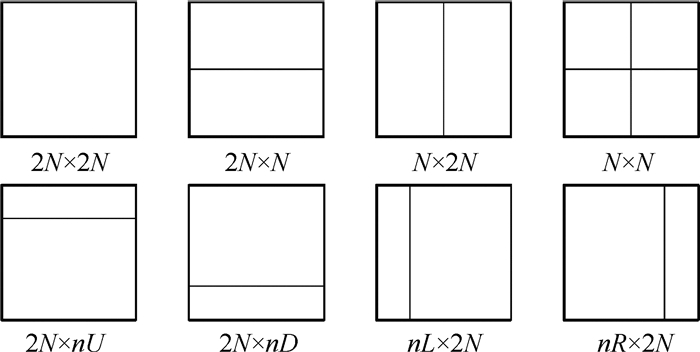-
摘要:
图片、语音、视频等多媒体形式的信息交流在网络通信中占有重要地位,同时也有很多非法信息的传播隐匿于此。隐写分析是甄别隐秘信息是否存在的有效手段,提出了一种通用的基于多尺度残差卷积网络的HEVC视频隐写分析算法。网络主体由残差计算、特征提取和二分类3部分构成,其中在特征提取部分针对性地提出了残差卷积层、多尺度残差卷积模块及隐写分析残差块。实验结果表明:所提算法基于视频像素域分析网络的检测率高达99.75%,比传统的手工提取特征方法具有更大的优势。
Abstract:The information exchange, in the forms of pictures, voice, video and other multimedia, plays an important role in network communication, as well as many illegal information disseminations are hidden. Steganalysis is an effective way of detecting secret information. This paper proposes a universal HEVC video steganalysis algorithm based on multi-scale residual convolution network, mainly consisting of residual calculation, feature extraction and binary classification. In the feature extraction part, residual convolution layer, multi-scale residual convolution module and a steganalysis residual block are proposed. Our experimental results show that the detection rate of this method based on video pixel domain analysis network is as high as 99.75%, which has greater advantages than the traditional manual feature extraction methods.
-
Key words:
- steganalysis /
- HEVC /
- deep learning /
- video /
- convolution network
-
表 1 PU划分类型与整数的映射规则
Table 1. PU partition types and integer mapping rule
PU划分类型 映射整数 2N×2N 0 N×N 1 N×2N 2 2N×N 3 nL×2N 4 nR×2N 5 2N×nU 6 2N×nD 7 表 2 实验结果对比
Table 2. Comparison of experimental results
算法 检测率/% CGPD传统特征 91.36 NRCNN 99.03 MSSN 99.75 -
[1] JAINSKY J S, KUNDUR D, HALVERSON D R. Towards digital video steganalysis using asymptotic memoryless detection[C]//Proceedings of Multimedia & Security, 2007: 161-167. [2] WU H T, LIU Y, HUANG J, et al. Improved steganalysis algorithm against motion vector based video steganography[C]//IEEE International Conference on Image Processing. Piscataway: IEEE Press, 2014: 5512-5516. [3] 孔维国, 王宏霞, 王科人, 等. 基于转移概率矩阵的H. 264/AVC视频帧内预测模式信息隐藏检测算法[J]. 四川大学学报(自然科学学报), 2014, 51(6): 1183-1191. https://www.cnki.com.cn/Article/CJFDTOTAL-SCDX201406014.htmKONG W G, WANG H X, WANG K R, et al. Steganalysis of intra-prediction mode modulated information hiding algorithms based on transition probability matrix for H. 264/AVC video[J]. Journal of Sichuan University (Natural Science Edition), 2014, 51(6): 1183-1191(in Chinese). https://www.cnki.com.cn/Article/CJFDTOTAL-SCDX201406014.htm [4] NIE Q, XU X, FENG B, et al. Defining embedding distortion for intra prediction mode-based video steganography[J]. Computers, Materials & Continua, 2018, 55(1): 59-70. http://qikan.cqvip.com/Qikan/Article/Detail?id=7100590268 [5] 盛琪, 王让定, 黄美玲, 等. 一种针对HEVC预测模式隐写的检测算法[J]. 光电子·激光, 2017, 28(4): 433-440. https://www.cnki.com.cn/Article/CJFDTOTAL-GDZJ201704014.htmSHENG Q, WANG R D, HUANG M L, et al. A prediction mode steganalysis detection algorithm for HEVC[J]. Journal of Optoelectronics·Laser, 2017, 28(4): 433-440(in Chinese). https://www.cnki.com.cn/Article/CJFDTOTAL-GDZJ201704014.htm [6] LI Z, MENG L, XU S, et al. A HEVC video steganalysis algorithm based on PU partition modes[J]. Computers, Materials & Continua, 2019, 58(2): 563-574. http://doc.paperpass.com/journal/20190032jsjclhlxtyw.html [7] HUANG K, SUN T, JIANG X, et al. Combined features for steganalysis against PU partition mode-based steganography in HEVC[J]. Multimedia Tools and Applications, 2020, 79(41): 31147-31164. doi: 10.1007/s11042-020-09435-y [8] YANG Y, LI Z, XIE W, et al. High capacity and multilevel information hiding algorithm based on PU partition modes for HEVC videos[J]. Multimedia Tools and Applications, 2019, 78(7): 8423-8446. doi: 10.1007/s11042-018-6859-7 [9] QIAN Y, DONG J, WANG W, et al. Deep learning for steganalysis via convolutional neural networks[C]//Proceedings of SPIE-The International Society for Optical Engineering, 2015, 9409: 94090J. [10] YE J, NI J, YI Y. Deep learning hierarchical representations for image steganalysis[J]. IEEE Transactions on Information Forensics and Security, 2017, 12(11): 2545-2557. doi: 10.1109/TIFS.2017.2710946 [11] ZENG J, TAN S, LI B, et al. Large-scale JPEG image steganalysis using hybrid deep-learning framework[J]. IEEE Transactions on Information Forensics and Security, 2018, 13(5): 1200-1214. doi: 10.1109/TIFS.2017.2779446 [12] BOROUMAND M, CHEN M, FRIDRICH J. Deep residual network for steganalysis of digital images[J]. IEEE Transactions on Information Forensics and Security, 2019, 14(5): 1181-1193. doi: 10.1109/TIFS.2018.2871749 [13] LIU P, LI S. Steganalysis of intra prediction mode and motion vector-based steganography by noise residual convolutional neural network[C]//3rd Annual International Conference on Cloud Technology and Communication Engineering, 2020, 719: 012068. [14] 黄雄波, 胡永健, 王宇飞. 针对视频运动向量隐写的深度神经网络检测方法[J]. 华南理工大学学报(自然科学版), 2020, 48(8): 5-13. https://www.cnki.com.cn/Article/CJFDTOTAL-HNLG202008001.htmHUANG X B, HU Y J, WANG Y F. A detection method with deep neural networks for video motion vector steganography[J]. Journal of South China University of Technology(Natural Science Edition), 2020, 48(8): 5-13(in Chinese). https://www.cnki.com.cn/Article/CJFDTOTAL-HNLG202008001.htm [15] XIE W, LI Z, WANG J, et al. An information hiding algorithm for HEVC videos based on PU partitioning modes[C]//International Conference on Cloud Computing and Security, 2018: 252-264. [16] LI Z, MENG L, JIANG X, et al. High capacity HEVC video hiding algorithm based on EMD coded PU partition modes[J]. Symmetry, 2019, 11(8): 1015. doi: 10.3390/sym11081015 [17] HE K, ZHANG X, REN S, et al. Deep residual learning for image recognition[C]//Proceedings of the IEEE Conference on Computer Vision and Pattern Recognition. Piscataway: IEEE Press, 2016: 770-778. [18] ZEILER M D. ADADLTA: An adaptive learning rate method[EB/OL]. (2012-10-22)[2021-04-01]. https://arxiv.org/abs/1212.5701. -







 下载:
下载:











